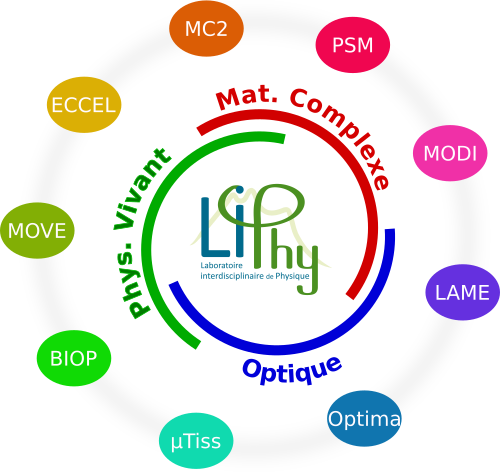- Share
- Share on Facebook
- Share on X
- Share on LinkedIn
The researchers of LIPhy are mainly physicists carrying out activities at the interface with other disciplines. The laboratory is composed of nine teams organized according to three main research axes.

Physics of life
-
Instrumental developments for the observation, study or manipulation of living beings: high definition optical imaging of cells or tissues, spectrometry and detection of individual molecules in vivo or in vitro, fluorescent, photochemical or immunological markers, microfluidic devices.
-
Studies of the physical properties or behavior of biological objects and molecules, individual cells or populations dispersed or agglomerated in tissues, of their own or induced evolution.
Many of these studies involve partnerships with biology or medical research laboratories
Complex matter
-
Study of the morphology and dynamics (deformations and movements) of soft objects: vesicles, drops, bubbles, shells, plates...
-
Study of the mechanical properties and flow of "complex" fluids: suspension of bubbles, vesicles, polymers, biological cells.
-
Study of the organization, deformation and movement of organic molecules within a crystal, a liquid or a gel evolving spontaneously or subjected to different mechanical, thermal, phtotonic solicitations...
Some of these researches have implications in biology and medicine either because they concern "biomimetic" objects whose structure and behavior remind of situations encountered in living beings, or because they directly concern biological objects (cells, biomolecules).
Optics
-
Ultra-high sensitivity spectrometry for trace gas detection, planetary atmosphere analysis, remote measurements...
-
Imaging of translucent media (including the observation of thick living tissues), very high resolution or very high sensitivity optical imaging (detection of individual molecules)
-
Photophysics and photochemistry of molecules, often of biological interest or even present in living cells, experimental and/or theoretical study of molecules very far from their equilibrium state
-
The development of original laser sources adapted to the studied applications, and the study of radiation-matter interactions
- Share
- Share on Facebook
- Share on X
- Share on LinkedIn